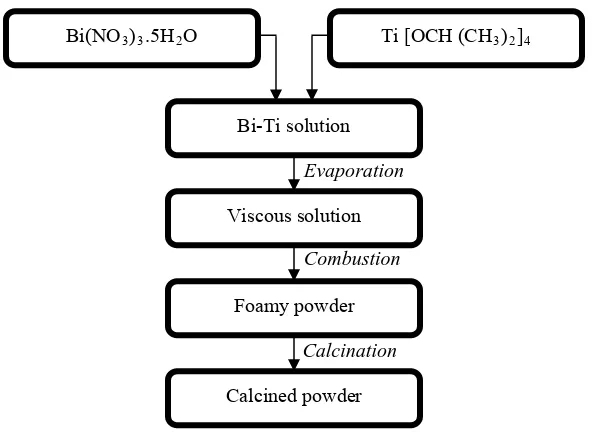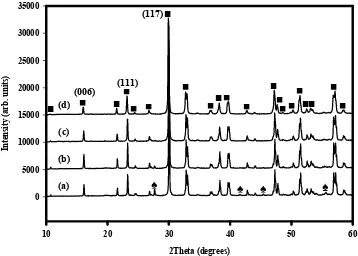Effect of Bi and Ti additions on the phase formation of Bi4Ti3O12 using fuel-free
combustion method
A.U. Al-Amani, S. Sreekantan*, M.N. Ahmad Fauzi*
*School of Materials and Mineral Resources Engineering, Universiti Sains Malaysia, 14300 Nibong Tebal, Penang, Malaysia.
E-mail: [email protected]; [email protected]
Abstract
Bi4Ti3O12 was synthesized by fuel-free combustion method using Bi (NO3)3.5H2O and Ti [OCH (CH3)2]4
and subsequent calcination. The effect of processing parameters such as Bi addition and Ti addition on the phase formation of Bi4Ti3O12 was investigated. X-Ray Diffraction analysis was used to determine the
formation of Bi4Ti3O12. Pure Bi4Ti3O12 powder was successfully formed with Ti addition after calcination
at 800oC for 3 h. The average crystallite sizes produced were 77.9 nm, 63.6 nm and 51.8 nm with mol ratio of 4:3.1, 4:3.4 and 4:3.6, respectively. The results obtained infer that the relative amount of Ti was identified as limiting reagent in the combustion reaction and was also considered as key factor to achieve single-phase Bi4Ti3O12.
c loss .
Keywords: Bi4Ti3O12; Bi rich phase; Ti addition
1.0 Introduction
Bismuth titanate, Bi4Ti3O12 was first described by Aurivillius in the late 1940s and early 1950s (1). This
composition is also known as bismuth based layered ferroelectric oxide and sometimes as bismuth layer structure perovskite. The name was given due to its outstanding properties of ferroelectric which is a special type of dielectric material. The structure of Bi4Ti3O12 can be written with a general formula of
(Bi2O2)2- (Am-1BmO3m+1)2+ where A=Bi, B=Ti and m is equal to 3 (2). It consists of interleaved layers of
bismuth oxide (Bi2O2)2+ with perovskite units (Bi2Ti2O102-) and these units are the region where
ferroelectric is generated for its application (1).
The Bi4Ti3O12 phase is originally forms in monoclinic at room temperature and upon heating to 600 oC,
this phase is then transforms to tetragonal and afterwards changes to orthorhombic at 750 oC with a= 0.5448 nm, b= 0.5411 nm, c=3.283 nm (1-3). With a wide range of temperature, Bi4Ti3O12 is very useful for
various applications such as memory storages, optical displays, piezoelectric converters and pyroelectric devices (4). As of today, Bi4Ti3O12 is being developed for the wireless telecommunication technologies and
it requires very stringent criteria such as high dielectric constant and low dielectri (1)
The properties of Bi4Ti3O12 are highly dependent on the physical and chemical characteristics such as
stoichiometry, homogeneity, phase purity and particle size distribution (1). To achieve desired properties, wet chemical method such as hydrothermal, co-precipitation, sol-gel and chemical synthesis were investigated by several authors (2, 4-7). Shi et al. (8) have prepared the hydrothermal synthesis of Bi4Ti3O12
using complex precursors of bismuth nitrate, titanium dioxide, titanium dioxide gel, tetrabutyl titanate which was then added with mineralizer KOH. Yang et al. (9) have synthesized Bi4Ti3O12 nanoparticles by a
low temperature ranging of 180 oC – 230 oC for 4 h - 12 h from bismuth nitrate, titanium chloride and sodium hydroxide. Pookmanee et al. (10) have reported the Bi4Ti3O12 powder was synthesized with longer
heat treatment up to 15 h at 150 oC. However, there has some limitation such as requires complex preparation during synthesis activity and needs longer heat treatment to induce the reaction.
of low cost precursors resulting in a compositionally homogeneous mixture. It is based on the fact that wet chemical technique (one part of fuel-free combustion method) can form stable solution with better ion distribution (13). This method is capable to produce fine powder after combustion takes place (14). Finally, the experimental set-up is very simple (15). Hence, Bi4Ti3O12 has synthesized in our laboratory by fuel-free
combustion method, which was based on aqueous solutions of nitrate salts and titanium (IV) isopropoxide.
2.0 Experiment procedure
The Bi4Ti3O12 powders were prepared by fuel-free combustion method using bismuth nitrate, Bi
(NO3)3.5H2O and titanium isopropoxide, Ti [OCH (CH3)2]4 as the precursor, 2-Methaoxyethanol as the
solvent and acetylacetone as the chelating agent (as shown in Fig.1). The typical procedure was the following. Firstly, Bi solution was prepared by adding Bi (NO3)3.5H2O into 2-Methaoxyethanol and
stirring at 40 oC for 30 min. Secondly, Ti solution was formed by dissolving Ti [OCH (CH3)2]4 in
2-Methaoxyethanol and acetylacetone and stirring for 30 min. Finally, Ti solution was poured into Bi solution with continuous stirring at 40 oC for 3 h. The temperature setting was then rapidly increased to 130 oC where combustion took place. The obtained powder was sent for calcination at 800 oC with soaking time of 3 h. The phase structures of the obtained powders were characterized by X-ray diffraction, XRD (Bruker D8 Advanced). The crystallite size was calculated using Scherrer’s formula at (117) and (111)-reflection on a-axis and (006)-reflection on c-axis peaks position.
Bi(NO3)3.5H2O Ti [OCH (CH3)2]4
Bi-Ti solution
Viscous solution
Foamy powder
Evaporation
Calcination Combustion
Calcined powder
Fig. 1: Preparation of Bi4Ti3O12 using free-fuel combustion method.
3.0 Result and discussion
3.1 Effect of Bi addition
Fig. 2 shows XRD patterns of the Bi4Ti3O12 powders having an excess of Bi at mol ratio of 4.4:3 and
stochiometric composition of 4:3. The Bi4Ti3O12 and Bi12TiO20 phases are observed in both powders. The
peaks corresponding to the intermediate phase of Bi12TiO20 appeared at 27.8o, 41.8o, 45.4o and 55.7o. The
Bi12TiO20 diffraction peaks, however, reduced gradually to a minimum content for the powder with the
reported that Bi rich phase appeared as intermediate phase prior to formation of Bi4Ti3O12 phase.
Meanwhile, Bae et al. (15) reported that Bi4−xLaxTi3O12 phase was fully obtained with the excess of 10mol%
of Bi (NO3)3.5H2O. However, Stojanovic et al. (3) stated that the excess of 3wt% Bi2O3 did not improve
the milling activity for the formation of Bi4Ti3O12 due to small presence of Bi12TiO20 and their starting
materials of Bi2O3 and TiO2 phases. In order to compare with present study, the presence of Bi12TiO20 at a
calcination temperature of 800oC was not successfully to be eliminated for the powders having Bi excess and stochiometric composition. Therefore, it implies that the parameter of Bi addition was not resulted on the formation of single phase of Bi4Ti3O12 significantly.
2 Theta (degrees)
Fig. 2: X-ray diffraction patterns of Bi4Ti3O12 powders prepared at different Bi ratio and calcined at 800oC for 3h; (a) Bi:Ti=4.4:3 and (b) Bi:Ti=4:3 [■:Bi4Ti3O12 / ♠:Bi12TiO20].
3.2 Effect of Ti addition
The XRD patterns of the powders having an excess of Ti at different ratio is shown in Fig. 3. The Bi12TiO20 peaks completely disappeared as the increased of Ti content and all the peaks formed
corresponding to Bi4Ti3O12 phase in orthorhombic structure. In this context, Ti is known as limiting
reagent due to its presence into the combustion reaction is in small amount. It is based on the stoichiometry equation that mol number of Ti is less than Bi-mol number. As a result, Ti needs to be added in relevant ratio in order to reduce the Bi rich phase. The average crystallite size calculated for the peak position of (117), (111) and (006) according to the Scherrer equation is shown in Table 1. The crystallite size produced at ratio of 4:3.1 is 77.9 nm. However, the crystallite size was gradually decreased to 63.6 nm and 51.8 nm at ratio of 4:3.4 and 4:3.6, respectively. The size obtained is smaller than the size reported by Goh et. al (14) where at peak position of (117) the Bi4Ti3O12 has the largest crystallite size of 97.46 nm. The lattice
constant ‘a’ and ‘c’ are found to be increased as the increased of Ti content. This result indicates that the ratio of the lattice constant of Bi4Ti3O12, c/a is a function of the Ti content. The ratio of c/a slightly
decreases from 6.032 to 6.010 for 4:3.1 to 4:3.6, respectively. The difference of lattice constant of ‘a’ and ‘c’ for the powder ratio of 4:3.1 is well to be said not so obvious as compared to the lattice constant recorded from PDF file of 01-089-7500. Thus, the c/a value of the powder is quite close and well accepted
2Theta (degrees)
Fig. 3: X-ray diffraction patterns of Bi4Ti3O12 powders prepared at different Ti ratio and calcined at 800oC for 3h; (a) Bi:Ti=4.3, (b) Bi:Ti=4.3.1, (c) Bi:Ti=4:3.4 and (d) Bi:Ti=4:3.6 [■:Bi4Ti3O12/
♠:Bi12TiO20].
Table 1: Crystallite size, lattice constant (a, c) and ratio c/a
Sample (Bi:Ti) 4:3.1 4:3.4 4:3.6 01-089-7500
Bi4Ti3O12 powder was synthesized using fuel-free combustion method. The studies from different
perceptive on precursor solution which focused on Bi addition and Ti addition led to different phase formation. The former attempts had resulted the presence of Bi rich phase of Bi12TiO20 while the later
attempt had successfully formed pure single-phase of Bi4Ti3O12 with orthorhombic structure after
calcination at 800oC for 3 h.
5.0 Acknowledgements
6.0 References
(1) Lazarević Z., Stojanović B.D., Varela, J.A., An Approach to Analyzing Synthesis, Structure and Properties of Bismuth Titanate Ceramics, Science of Sintering, 37, 2005, pp.199-216.
(2) Thongtem, T., Thongtem, S., Characterization of Bi4Ti3O12 powder prepared by the citrate and oxalate
coprecipitation processes, Ceramics International, 30, 2004, pp. 1463–1470.
(3) Stojanovic´, B.D., Paiva-Santos, C.O., Cilense, M., Jovalekic´, C., Lazarevic´, Z.Z., Structure study of Bi4Ti3O12 produced via mechanochemically assisted synthesis, Materials Research Bulletin, 43, 2008,
pp. 1743–1753.
(4) Umabala, A.M., Suresh, M., Prasadarao, A.V., Bismuth titanate from coprecipitated stoichiometric hydroxide precursors, Materials Letters, 44, 2000, pp. 175–180.
(5) Chen, D., Jiao, X., Hydrothermal synthesis and characterization of Bi4Ti3O12 powders from different
precursors, Materials Research Bulletin, 36, 2001, pp. 355–363.
(6) Chen, X.Q., Qi, H.Y., Qi, Y.J., Lu, C.J., Ferroelectric and dielectric properties of bismuth neodymium titanate ceramics prepared using sol–gel derived fine powders, Physics Letters, A 346, 2005, pp. 204– 208.
(7) Pookmanee, P., Chemical synthesis and characterization of lead-free bismuth titanate (Bi4Ti3O12) from
the oxalate method, Journal of Ceramic Processing Research, Vol. 9, No. 1, 2008, pp. 30-33.
(8) Shi, Y., Cao, C., Feng, S., Hydrothermal synthesis and characterization of Bi4Ti3O12, Materials Letters,
46, 2000, pp. 270–273.
(9) Yang, Q., Li, Y., Yin, Q., Wang, P., Cheng, Y., Bi4Ti3O12 nanoparticles prepared by hydrothermal
synthesis, Journal of the European Ceramic Society, 23, 2003, pp. 161–166.
(10) Pookmanee, P., Uriwilast, P., Phanichpant, S., Hydrothermal synthesis of fine bismuth titanate powders, Ceramics International, 30, 2004, pp. 1913–1915.
(11) Luo, S., Tang, Z., Yao, W., Zhang, Z., Low-temperature combustion synthesis and characterization of nanosized tetragonal barium titanate powders, Microelectronic Engineering, 66, 2003, pp. 147–152. (12) Patil, K.C., Hedge, M.S., Rattan, T., Aruna, S.T., Chemistry of Nanocrystalline Oxide Materials Combustion Synthesis, Properties and Applications, World Scientific Publishing Co. Pte. Ltd., Singapore, 2008, pp. 42 (Chapter 3).
(13) Ries, A., Simo˜es, A.Z., Cilense, M., Zaghete, M.A., Varela, J.A., Barium strontium titanate powder obtained by polymeric precursor method, Materials Characterization, 50, 2003, pp. 217– 221. (14) Goh, P.Y., Razak, K.A., Sreekantan, S., Structural and morphology studies of praseodymium-doped bismuth titanate prepared using a wet chemical route, Journal of Alloys and Compounds, xxx, 2008, pp. xxx–xxx.
(15) Bae, J.C., Kim, S.S., Choi, E.K., Song, T.K., Kim, W.J., Lee, Y.I., Ferroelectric properties of
lanthanum-doped bismuth titanate thin films grown by a sol–gel method, Thin Solid Films, 472, 2005, pp. 90–95.
(16) Han, K., Ko, T., Synthesis and phase formation of ferroelectric Bi4Ti3O12 nanopowder by mechanical

![Fig. 2: X-ray diffraction patterns of Bi 4Ti3O12 powders prepared at different Bi ratio and calcined at 800oC for 3h; (a) Bi:Ti=4.4:3 and (b) Bi:Ti=4:3 [■:Bi4Ti3O12 / ♠:Bi12TiO20]](https://thumb-ap.123doks.com/thumbv2/123dok/624747.75440/3.612.135.502.203.457/diffraction-patterns-powders-prepared-different-ratio-calcined-tio.webp)
